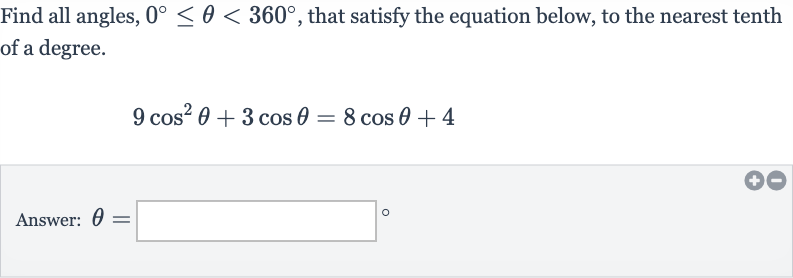Full solution
Q. Find all angles, , that satisfy the equation below, to the nearest tenth of a degree.Answer:
- Rewrite Equation: Rewrite the given equation to collect all terms on one side and set the equation to zero.Simplify the equation by combining like terms.
- Simplify Equation: Factor the quadratic equation in terms of . = \)Set each factor equal to zero to find the values of . and
- Factor Quadratic Equation: Solve each equation for . For : For : However, since the cosine of an angle cannot be greater than , is not a valid solution.
- Solve for : Find the angles that correspond to in the range 0^\circ \leq \theta < 360^\circ. Use the inverse cosine function and consider the symmetry of the cosine function, which is positive in the first and fourth quadrants and negative in the second and third quadrants. Calculate the principal value.
- Find for : Find the second angle in the range 0^\circ \leq \theta < 360^\circ that also has a cosine of .Since cosine is negative in the second and third quadrants, the second angle is the supplement of the principal value.
More problems from Csc, sec, and cot of special angles
QuestionGet tutor help
QuestionGet tutor help
QuestionGet tutor help
QuestionGet tutor help
QuestionGet tutor help
QuestionGet tutor help
Question
. Find the value of in degrees.Write your answer in simplified, rationalized form. Do not round.____
Get tutor helpQuestionGet tutor help

